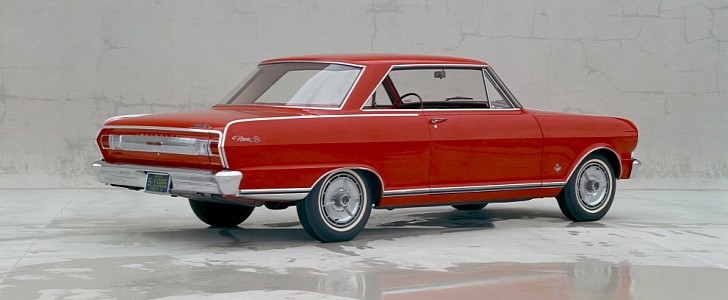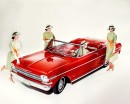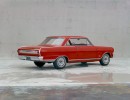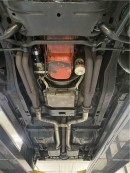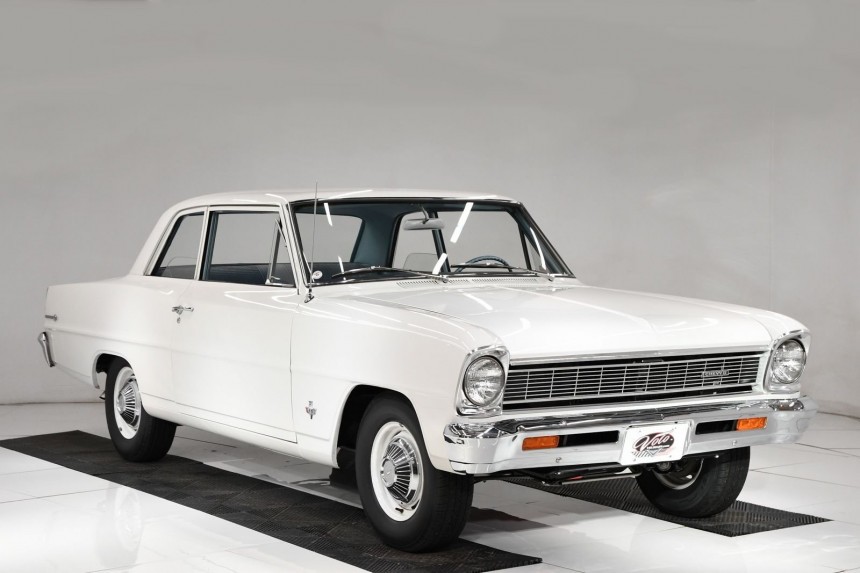Introduced for the 1960 model year, the Ford Falcon made GM realize they also needed a small-ish car with little in the way of goodies to keep the price as low as possible. GM knew they were losing a lot of market share when the Falcon started to outsell the rear-engined Corvair, which is just a little shorter than the Chevy II that would be later renamed the Nova.
The Chevrolet Chevy II came to be in merely 18 months from the drawing board to rollout. I can’t stress how quick that is for the 1960s automotive industry, back in the day when they didn’t have computers to aid with the vehicle’s development and Internet to coordinate all the R&D teams as efficiently as possible. General Motors have also developed a platform specifically for this application, the X-body architecture that would be shared with the Acadian Invader for the Canadian market, the Buick Apollo, Skylark, Oldsmobile Omega, Pontiac Ventura, the ‘74 GTO, and Phoenix.
Introduced on September 29th, 1961, for the 1962 model year, the Chevy II embodies maximum functionalism with thrift according to Ed Cole. You know, the gentleman who led the design for the first generation of the small-block V8. He also led the development of the Corvair and Vega, and he’s also the guy responsible for reducing engine compression ratios in preparation for the phased-in reduction of tetraethyl lead (TEL) in all gasoline grades.
Five different body styles (two-door sedan, two-door coupe, two-door convertible, four-door sedan, four-door station wagon), two engine choices (a 153 four-cylinder and a 194 six-cylinder), a couple of transmissions (three-speed manual and two-speed Powerglide), and three series (100, 300, 400) were offered. The range-topping series was actually called Nova 400.
For the 1963 model year, the Chevy II Nova 400 line was upgraded with the Super Sport trim option that wasn’t much of a performance booster. It was 1964 when Chevrolet made a case for the 283 small-block V8 with 195 and 220 horsepower. Adequately stout for such a light car, the 4.6-liter mill transformed the economy car’s plain image into an unexpected performer.
Come 1965, General Motors added the 327 in two states of tune: 250 and 300 horsepower. When specified with the four-speed manual and 3.36 gears, the Chevy II was more than capable of giving the Mustang 289, GTO, and 4-4-2 a run for their money in terms of straight-line acceleration. 1965 also happens to be the first year of the legendary 12-bolt Positraction diff.
An extensive restyling of the Chevy II occurred in 1966 when the L79 version of the 327 made this fellow a thoroughbred muscle car. 350 horsepower and 360 pound-feet (490 Nm) of torque in a no-frills car that’s lighter than a first-gen Subaru BRZ is an endearing recipe for driving fun, don’t you think?
Fast forward to 1968, and the Gen III introduced big-block power in the guise of the L34 and L78. This year, the Super Sport morphed into a performance package that rocked up to 375 horsepower and 415 pound-feet (563 Nm) of torque at 3,600 revs from 6.5 liters of displacement. Disc brakes were optional on the Super Sport, and the following year, Chevrolet finally dropped Chevy II in favor of the name we all know and love: Nova.
It’s also worth mentioning that General Motors produced SS vehicles with the 402 engine for the 1970 model year rather than the 396 mentioned earlier. Curiously enough, these cars feature 396 badging and the same ratings as the 6.5-liter motor. From 1971 onward, Chevrolet gave up a lot of the Nova’s go-faster bragging rights over the change to nonleaded fuel.
Despite lower compression ratios and the lack of a big-block lump, the Rochester Quadrajet-carbureted 350 in the Nova SS was capable of clocking 15 seconds over the quarter-mile, fully stock. But anyway, sales of the Nova SS have dropped tremendously in 1971. More to the point, General Motors sold 7,015 units compared to 19,558 in the previous year.
Still based on the X-body platform, the fourth-generation Nova was offered with an SS option that can only be described as a visual package with no extra go. The fifth-generation model steered clear off the ‘60s-era curves, only to make way for the front-wheel-drive Citation in 1979. A car so terrible it nearly ruined GM’s reputation, the Citation is remembered for seriously bad rust issues, crumbled suspension mounts, and defective brakes.
General Motors revived the Nova in 1984 for the 1985 model year with front-wheel drive, but on this occasion, they used the AE82 vehicle architecture from the Toyota Corolla. The sixth generation was produced in Fremont at the plant where Tesla currently makes its highly desirable EVs.
The final year of the final incarnation of the Nova is 1988.
Introduced on September 29th, 1961, for the 1962 model year, the Chevy II embodies maximum functionalism with thrift according to Ed Cole. You know, the gentleman who led the design for the first generation of the small-block V8. He also led the development of the Corvair and Vega, and he’s also the guy responsible for reducing engine compression ratios in preparation for the phased-in reduction of tetraethyl lead (TEL) in all gasoline grades.
Five different body styles (two-door sedan, two-door coupe, two-door convertible, four-door sedan, four-door station wagon), two engine choices (a 153 four-cylinder and a 194 six-cylinder), a couple of transmissions (three-speed manual and two-speed Powerglide), and three series (100, 300, 400) were offered. The range-topping series was actually called Nova 400.
For the 1963 model year, the Chevy II Nova 400 line was upgraded with the Super Sport trim option that wasn’t much of a performance booster. It was 1964 when Chevrolet made a case for the 283 small-block V8 with 195 and 220 horsepower. Adequately stout for such a light car, the 4.6-liter mill transformed the economy car’s plain image into an unexpected performer.
Come 1965, General Motors added the 327 in two states of tune: 250 and 300 horsepower. When specified with the four-speed manual and 3.36 gears, the Chevy II was more than capable of giving the Mustang 289, GTO, and 4-4-2 a run for their money in terms of straight-line acceleration. 1965 also happens to be the first year of the legendary 12-bolt Positraction diff.
An extensive restyling of the Chevy II occurred in 1966 when the L79 version of the 327 made this fellow a thoroughbred muscle car. 350 horsepower and 360 pound-feet (490 Nm) of torque in a no-frills car that’s lighter than a first-gen Subaru BRZ is an endearing recipe for driving fun, don’t you think?
It’s also worth mentioning that General Motors produced SS vehicles with the 402 engine for the 1970 model year rather than the 396 mentioned earlier. Curiously enough, these cars feature 396 badging and the same ratings as the 6.5-liter motor. From 1971 onward, Chevrolet gave up a lot of the Nova’s go-faster bragging rights over the change to nonleaded fuel.
Despite lower compression ratios and the lack of a big-block lump, the Rochester Quadrajet-carbureted 350 in the Nova SS was capable of clocking 15 seconds over the quarter-mile, fully stock. But anyway, sales of the Nova SS have dropped tremendously in 1971. More to the point, General Motors sold 7,015 units compared to 19,558 in the previous year.
Still based on the X-body platform, the fourth-generation Nova was offered with an SS option that can only be described as a visual package with no extra go. The fifth-generation model steered clear off the ‘60s-era curves, only to make way for the front-wheel-drive Citation in 1979. A car so terrible it nearly ruined GM’s reputation, the Citation is remembered for seriously bad rust issues, crumbled suspension mounts, and defective brakes.
General Motors revived the Nova in 1984 for the 1985 model year with front-wheel drive, but on this occasion, they used the AE82 vehicle architecture from the Toyota Corolla. The sixth generation was produced in Fremont at the plant where Tesla currently makes its highly desirable EVs.
The final year of the final incarnation of the Nova is 1988.
